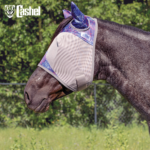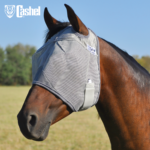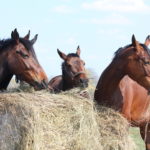If you intend to purchase a horse off the track, or adopt through a program, I recommend you engage the assistance of an experienced friend or trainer to help ascertain the horse’s suitability for you and your discipline. Even if you buy and sell horses all the time, a second opinion is always of value.
The most important step is to ask yourself what level of riding or competition you aspire to, as many off-the-track Thoroughbreds (OTTBs) are athletic enough to pursue any discipline at the lower levels, and most minor injuries will hold up after proper time off. With this in mind, here are a few additional guidelines to consider when evaluating OTTBs. These are generalized suggestions–there is a lot more to consider when choosing a horse for a specific discipline.
Potential event horse or jumper Photo by Carrie Paston
The Event Horse
Conformation
- High shoulder point (the front of the shoulder is high, with a steeply angled humerus from there to the elbow; this ensures scope over large jumps)
- Uphill build
- Medium bone structure (extremely fine bone structure is less likely to hold up)
- Short- to medium-length back
- Short- to medium-length pasterns (long pasterns tend to break down)
- Well-set knees (horses “straight” in the knees are prone to knee injuries)
- Event horses can range in height. Note that larger horses (in height and mass) can be more difficult to keep sound as they are harder on their legs and feet.
Movement
Event horses need to be very athletic with fluid gaits. Prospects should have more “action” at all three gaits than, say, a hunter (see below). This often indicates it will be easier for them to move with impulsion in the dressage ring and that they will pick up their knees better over fences.Personality
Brave, athletic and hard-working. Event prospects need to be bold, brave and forward-going horses that have good endurance. Many of these horses could also be described as “proud” or “arrogant.” More energetic horses are often possibilities–as long as they are mentally sane and have a good work ethic, the extra energy is beneficial on the cross-country course. Injuries to Avoid
Breathing issues
Severe tendon injuries (mild strains or bows are generally not an issue if given enough time off prior to retraining)
Severe suspensory injuries
Joint chips or fractures
Vision limitations
The Jumper A jumper prospect will be very similar in build, action and personality to an event horse (see above). When looking for a jumper, put more emphasis on a stronger hind end and shoulder. A jumper does not necessarily need to be built uphill, but he should have a high shoulder point.
Potential hunter Photo by Carrie Paston
The Hunter ConformationLong, sloping shoulder
Neck ties in well with the withers and shoulder
Small, attractive head
Flat topline
Movement Hunters should be light on their feet and have as little action in their legs as possible. A long, low, rhythmic stride that easily covers a lot of ground is desirable. The horse’s head carriage should be long and low.
Personality Easygoing, consistent and stylish. Hunters are judged on rhythm, style, and manners. They need to be calm in nature and consistent in gait and attitude as they move around the ring and over fences.
Injuries to AvoidSevere tendon injuries (mild strains or bows are generally not an issue if given enough time off prior to retraining)
Severe suspensory injuries
Joint chips or fractures
Potential dressage horse Photo by Carrie Paston
The Dressage Horse ConformationWithers set back from the shoulder
Short back
Uphill build
Strong, well-built hindquarters
Neck ties in well with the withers and shoulder (avoid ewe-necked horses)
Neck should be medium to long
Movement The horse should naturally engage and drive from his hind end. A regular, even, four-beat walk is ideal. At the trot he should demonstrate natural impulsion and extension while remaining light on his feet. Look for a canter that is not overly “large”–a shorter stride is easier to maneuver around the dressage arena and eventually teach clean flying lead changes.
Personality Hard-working, sensitive and sensible. A dressage prospect should be a sensitive yet sensible horse. He needs to be very responsive to leg, seat, and rein aids rather than dead-sided or hard-mouthed. He cannot become overwrought every time he is confronted with a new task–the ideal horse likes to work and accepts new challenges eagerly.
Injuries to AvoidSevere tendon injuries (mild strains or bows are generally not an issue if given enough time off prior to retraining)
Severe suspensory injuries
Joint chips or fractures
This article is excerpted from the book Beyond the Track: Retraining the Thoroughbred from Racehorse to Riding Horse, which offers tips on finding the right OTTB and giving him the solid educational foundation he needs to excel in a new career. To order, call 800-952-5813 or visit HorseBooksEtc.com.





